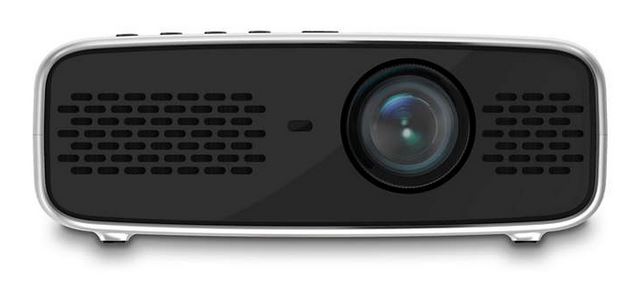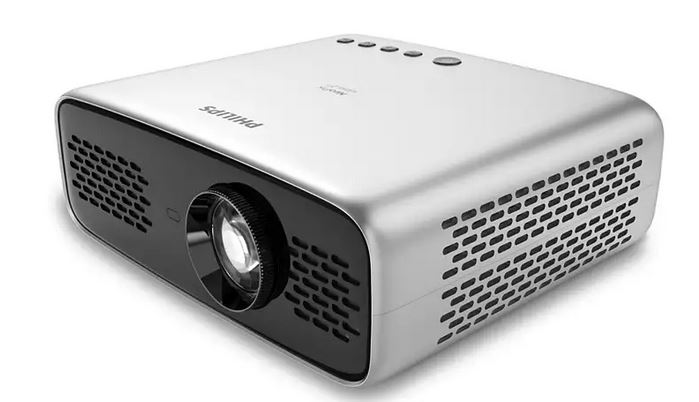Philips NeoPix Ultra 2TV is a smart Android TV projector suitable for a 100” image. But the built-in Android TV smarts make it stand out from the pack.
Now, I admit that I wrestle with use cases for projectors – any projectors. Sure, a 100” image is nice, but you need a very dark room and preferably a proper projection screen. Sure, the image is adequate, but its colours are not as vibrant. And, well, while it is ‘only $999, you can buy a 75”, 4K, 1 billion colour, HDR, Blaupunkt Android TV for not much more at JB Hi-Fi.
So, let’s look at the bright side. One hundred inches is impressive. Who says size does not matter? Completely darken the room, and the colours are acceptable (not picky, but they are a long way off an LED/LCD TV). And you have Android TV with Chromecast and its extensive range of apps.
So as long as you know both its strengths and weaknesses, we have done our job.
Philips NeoPix Ultra 2TV with Android TV Model NPX643/INT
| Website | here |
| Manual | here (note this is the international model) |
| Support | Amber Technology – Service Department Address: Unit 1, 2 Daydream St, Warriewood NSW 2102 |
| Price | $999 |
| From | JB Hi-Fi |
| Warranty | 2-years ACL |
| Country of Manufacture | China (Designed in Switzerland) |
| About | Philips (Est 1891) is a Dutch multinational with interests in lighting, consumer lifestyle, consumer healthcare and commercial health equipment |
| More | You can read more GadgetGuy Philips news and reviews here or projector reviews here |
The Philips Pix family
You can buy Pico based projector – LED light and usually portable – great for Nomads. They are not as bright, and resolution is often 720p, but the technology is improving. In fact, if you are just after one for occasional use, you will find them at JB Hi-Fi for under $500 (more if you want the Android TV version).
Then the NeoPix family is more traditional, using a sealed LED light unit and ranges from $695 to $999 (Philips NeoPix Ultra 2TV – this review).
The top of the line is the Philips Screeneo short-throw family for a ‘cinema’ experience in 1080p and 4K. They start around $3000, and I have yet to see any at retailers.
First impression – silver grey
Some projectors look great, and some, like this, are a little bland – typically white, silver, or black, with lots of air holes to dissipate heat and a big front lens. It is 277 x 310 x 111 mm x 2.7kg. The Remote control has more style. If it is to be a lounge room feature it needs loungeroom style!
Placement and mounting are the key issues
Ideally, this should be roof-mounted (mount extra) to keep obstacles out of its projection path. Similarly, it can be rear-mounted behind the screen, but that reduces brightness. Or place it on a 750-800mm high desk or countertop in front or rear. In all cases, you need 240V power and a reasonable line-of-sight for the IR remote (more on that later) to work.
The throw distance determines the image size (1.4:1). The manual states that from 80cm to 200cm, you get an image size of 24-60” – that is not 100”. But it falls within acceptable image brightness guidelines.
If you push it to around 3.5m, it will project a 100” image. But, brightness is almost down to unusable levels (for a very dark room only).
The projector has settings for focus, keystone, front/rear, roof/desk etc. It is easy to get a good rectangular 16:9 image.
Light source

It has a 30,000 hour sealed LED – after that, you dispose of it. Philips doesn’t disclose the lumens, but we measured light output of 200 lumens at 1m from the lens and a peak contrast of 3000:1 (FOFO full-on-to full-off). That is more like 1000:1 – about two-thirds of a good PC monitor.
The claim is it can produce a 100% REC 709 SDR (standard dynamic range) colour gamut similar to 100% sRGB. Sounds good, but it is nowhere near the later spec of DCI-P3 (<70% movie colours) or REC 2020 (<50%), which many TVs can attain.
The reality is that this projector cannot defeat ambient 400-lumen office light or greater. You really need to use it in a darkened room (<200 lumen light – dusk-to-night).
It can project 720p, 1080i, 1080p at a maximum of 60Hz refresh, but you will find mostly it will be at 24 or 30Hz.
Get a screen
You will get an inferior image if you project onto a painted wall, curtains, or blinds. These surfaces absorb light.
A proper projector screen is satin white (between matte and gloss) to minimise reflections. It has a gain factor of at least 1.0. In other words, if you throw 200 Lumens, it will reflect 200 Lumens. Typically, a 100” screen will cost $700-900 – motorised screens cost about $300-500 more.
Or you can try projector screen paint (we have not tried this). This paint needs to be latex-based, satin, neutral white (before any pigments). The trick here is to ensure the surface is absolutely smooth and ideally applied via spray paint (to avoid mottled roller finish). SmarterSurface has it at A$190 to cover about 6m2. It claims a gain factor of 1.0 and a viewing angle of 140°. If you have the right wall and light control, then it could be a low-cost option. It also has a Pro version (two-coat – primer and paint) that has a gain of 1.1 for $286.
Ports
In many respects, Android TV, via its dual-band Wi-Fi 5 AC and Bluetooth 4.2 with Chromecast, is about all you need. But it also has
- HDMI 1.4 ARC for a video source or soundbar
- USB 2.0 5V/1.2A for multimedia player and firmware updates
- SPDIF for soundbar
- 3.5mm 3-pole stereo sound jack
Note that if you want to stream DRM protected content from a TV or set-top-box, it must be via the HDMI cable. Wi-Fi only supports non-DRM content, e.g. YouTube.
Sound
It has two ‘booming 15W speakers with surround and bass boost for maximum power for a deep movie and music immersion’.
I don’t know who writes this marketing hype, but it has 2 x 15W peak (about 2x3W RMS), and the volume maximum is about 75dB with evident distortion.
At least it is stereo, has a wide enough soundstage to match the screen, and has enough grunt for a small room. Sound-wise it has reasonable bass, but recessed mid and treble drops right off.
This is a Bass signature: (bass boosted, mid/treble recessed) – for bass music but can sound boomy or muddy compared to warm and sweet (if it had stronger mids). For movie use, I would definitely recommend a 2.1 soundbar like the JBL 2.1 8.8/10 or Bose 2.0 300 7.9/10.

You can read more about sound signature and why it is so important here.
Gamers – only low frame rate
Input lag is too large for gamers.
Power – cheap to run
It consumes approx. 100Wh, so about five cents per hour.
Android TV – its reason for being
- Amlogic S905Y2 processor
- OS: Android 10.0
- DRAM: DDR 2GB Flash: 8GB eMMC
It is based on Android TV OS and has all major streaming channels (subscription may be required) and hundreds of handy apps. In addition, the Bluetooth paired remote can act as a Google Assistant speaker accessing everything it can do – smart home, content, calendar etc. Once paired, it does not need line-of-sight that an IR remote does.
GadgetGuy‘s take
As I said earlier, I struggle with understanding use cases for projectors – any projector. But we must be objective. The main use case is portability, and the main caveat is you need dark surroundings to watch it. For $999, you get up to 100” screen size, but it is significantly brighter and more colourful with a smaller 65-75” screen (1.4:1 throw), which makes it a fairer comparison to a 65-75” 4K TV.
Would I buy it? Philips sells containerloads of projectors, so who am I to argue, but you need a good screen/wall and watch it in low ambient light. And it’s a huge 3X price jump to a 4K, 3000 lumens projector!
Rating the Philips NeoPix Ultra 2TV is really a combination of features and price – both of which it wins on. As long as you are aware of scree and light issues, this passes all our test parameters.











what is the actual lumens of this product?
The actual lumens are 200 so it need to be in a darkened room. I have seen some advertisements (from dodgy merchants) claiming 2000 lumens but that is measured at the lamp and is not relevant.
Could it be used with Apple IOS? Or is it really to be used with Android?